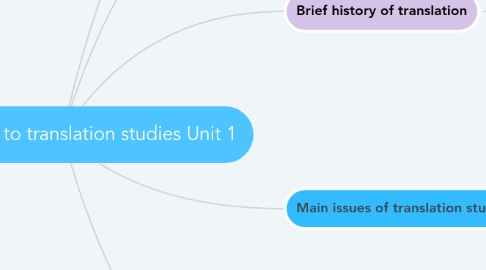Introduction to translation studies Unit 1
af Dafne Vazquez


1. Importance of translation studies
1.1. Global communication
2. Defining the term translation
2.1. "A rendering from one language to another".(Merriam-Webster,2022)
2.1.1. Intralingual
2.1.2. Interlingual
2.1.3. Nuevo Tema
3. Brief history of translation
3.1. Timeline across the centuries
3.1.1. Important authors
3.1.1.1. Translation of ancient religious texts
3.1.2. Previously used methods
3.1.2.1. Grammar-translation method, comparative literature, workshop, contrastive analysis
3.1.3. Scientific approach
3.1.3.1. Holmes /Toury map
3.1.3.2. Manipulation school
3.1.3.3. Cannibalist school
4. Main issues of translation studies
4.1. Translation styles
4.1.1. Word by word (metaphrase)
4.1.2. Sense by sense (paraphrase)
4.1.3. Adaptation (imitation)
4.2. Ethics in translation
4.2.1. Accuracy, faithfulness
4.2.2. Legal and moral consequences
4.2.3. Adaptation to market, tools and technology
4.2.4. Concordance with personal postures
